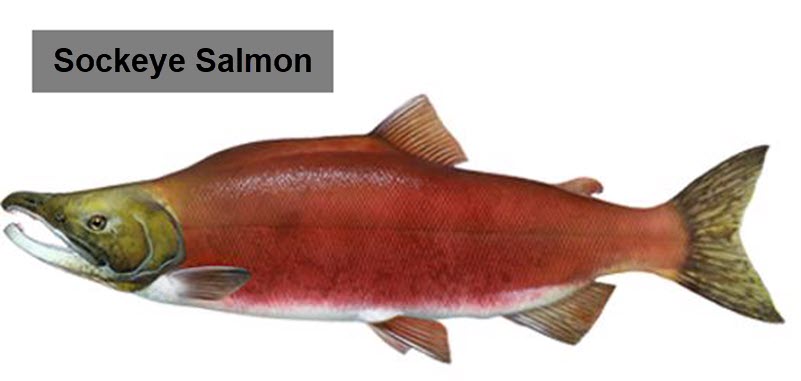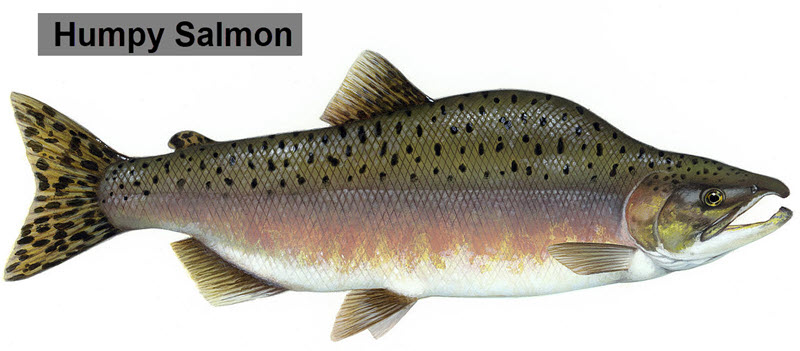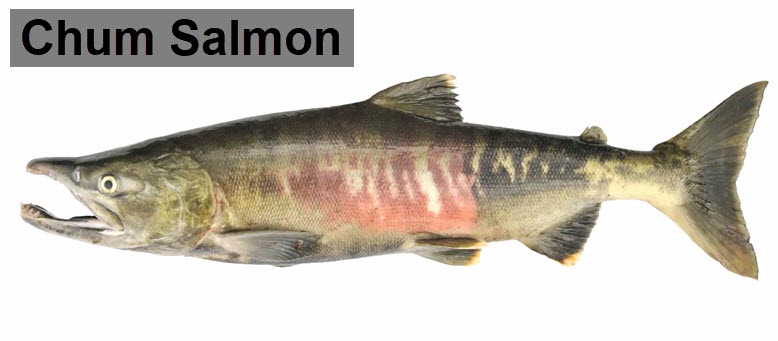There are 5 different types of Salmon can be found in Alaska. Most of them have similar features they differs eventually as time goes by. This means that the physical changes of each salmon differs depending on how long salmon stays in the river. With that, it would be difficult to distinguish each salmon because of the physical changes during spawning. In this guide, we are going to talk about the different types of salmon and each features to help identify spawning and non spawning salmon.
Different Types Of Salmon In Alaska
Each of the different types of Salmon in Alaska waters have unique characteristics. Read on below to know more.

King Salmon or Chinook Salmon
King Salmon or also known as Chinook Salmon. It is considered to be one of the largest species of Alaska salmon, but the least abundant amongst others that is why each catch is considered valuable. Aside from that, it is also the largest Alaskan King salmon that weighs about 126 lbs. was caught salmon sometime in 1949.
King salmon (Chinook Salmon) fish can weigh more than 40 lbs and is one of the most valuable commercial fish in the market. Its flesh is silky red although there are white king salmon that can be seen as well.
King Salmon egg are harvested for caviar in some countries such as Japan, China, and Russia.
King Salmon Preparation
It is an ideal fish for grilling and poaching because of its abundant oil content that gives that buttery flavor. Doesn’t matter how King salmon is cooked, make sure not to overdo with the seasonings. King Salmon in itself is already tasty and delish.
Most of the time, King salmon are used when making sushi, found mostly at the center of a restaurant (Chef’s Choice) and prepared as steaks, fillets and often as a whole fish served at the fish counters.
King Salmon Identification
One of the distinguishing mark that King Salmon has that differs from other salmon species is the presence of spots found on both the upper and lower lobes of the fin or tail. Also, Chinook’s mouth and gums have a black lining. The upper back of King Salmon has large spots.
King Salmon Availability
The months of Mid May to July is the ideal dates to catch salmon however King salmon can be caught throughout the year.

Silver Salmon or Coho Salmon
Coho or also known as Silver Salmon because of its bright silver sides although a more lighter flavor in comparison to King Salmon or Sockeye salmon. Also, because of its orange-red colored flesh that is a little fatty most of the restaurants prefer to use Silver Salmon for fillets.
Silver Salmon is considered to be the second largest Salmon found in Alaska waters next to King Salmon.
Silver Salmon has an average size between 8 to 12 pounds and about 24 to 30 inches in length.
Silver Salmon Preparation
Silver Salmon is an ideal Salmon fish for grilling, broiling, poached in either oil or butter, Sautéed, and often smoked.
Silver Salmon Identification
Side are silvery with metallic blue back and have black spots that are irregular. The most identifiable and distinguishing feature Coho Salmon has that differs it from the rest of salmon is the inside of the mouth which is black but with white gums.
Although Silver Salmon is available for catch all year round, most of the fresh once are caught between mid June to late October.

Red or Sockeye Salmon
Red or also known as Sockeye Salmon. It is considered to be the third most abundant salmon species. Another important type of salmon species in Alaska waters.
It is large enough and can weigh between 6 up to 15 pounds and can grow for up to 3 feet long. The fish usually measures 20 to 24 inches. Most of the restaurants prefer Sockeye salmon because of its deep red coloring and its texture that retains its color even when Salmon is already cooked. The meat is fatty and firm but with flexible flavor.
Sockeye Salmon Preparation
Just like with King Salmon, Sockeye Salmon is prepared for both fresh and smoked. It is also made into lox, which is a fillet of salmon that may or may not be prepared smoked. Although Sockeye salmon is less buttery as compared to king salmon, sockeye salmon always find its way to the center of the restaurant. Also prepared as steaks, fillets and whole fish.
Sockeye Salmon Identification
Sockeye Salmon tails has no spots nor streaks. The mouth and gums are white. The back of Sockeye Salmon also does not have spots.
Availability of Sockeye Salmon
Adult sockeye salmon return as spawning sockeye salmon between the months of July and October. Fresh Sockeye salmon can be caught between mid-May to mid-September.

Pink or Humpy Salmon
Pink Salmon or Humpy Salmon is considered to be the smallest salmon among the rest of the salmon mentioned in this guide. It weighs only 3 to 5 pounds, but can go up to 14 pounds.
Although Pink Salmon are the smallest type, however, they are the most abundant of all the type of Salmon there is with over 140 million pink salmon caught. Most of the commercially caught Pink salmon annually are canned.
Pink Salmon Identification
It is called Humpy salmon simply because of how the adult males look like. It features a hooked snout as well as sharp teeth. And the most distinguishing and unique feature is the hump behind the head. On the other hand, female pink salmon will change its color into olive green.
Adult Pink salmon found in saltwater does not appear to have humps but rather have a steel blue to almost blue green on its back, on the sides it has a silver color and the belly looks white.
Moreover, the mouth is white, the gums and tongue are black.
Pink Salmon Preparation
The roe of Pink Salmon is used in making sushi preps. Most of the time, Pink salmon are found in frozen food section and prepared as salmon salad sandwich, salmon burgers and Sushi (roe).
Pink Salmon Availability
If you want to catch fresh Pink salmon, you can do so for the months of mid-June to September. Although canned preparations of Pink salmon is available throughout the year, in pouches and frozen salmons too.

Dog or Chum Salmon (Keta)
Keta Salmon or also known as Chum Salmon. Before, Chum salmon is not that abundant commercially, however as the years passed by Japan and Europe started to grow its market for fresh and frozen salmon and are now commercially harvested.
Chum Salmon usually weighs about 4 to more than 30 pounds but have an average of 7 to 18 pounds.
Chum Salmon Identification
For chum salmon from saltwater, the back of it shows a metallic to greenish blue color with presence of black speckles. The features is somewhat similar to Silver salmon or sockeye salmon when caught from the ocean because the color tends to change in fresh water.
The longer Chum salmon in the water, the more noticeably its vertical stripes colored red and black up to the sides are.
Chum Salmon Tail has no spots but with silver streaks that covers about half of its fin. The mouth is white with white gums. The teeth are developed too. At the back of Chum salmon, it also has no spots but the most identifiable mark that distinguishes Chum salmon from the rest of salmon species is the presence of Tiger stripes as spawning salmon.
Chum Salmon Preparation
Chum Salmons are dry fish that is why it is commonly prepared as dried fish in soup and chowders. Since Chum salmons has pale orange or red or pink flesh, a perfect salmon used for drying and smoking. Keta roe is also used in sushi.
Chum Salmon Availability
Fresh Chum salmon are abundant in months of June to September but is available all year round as frozen salmon.

